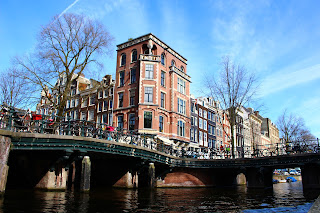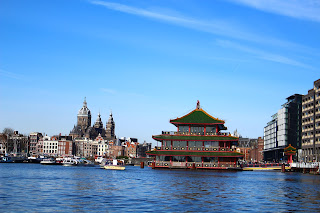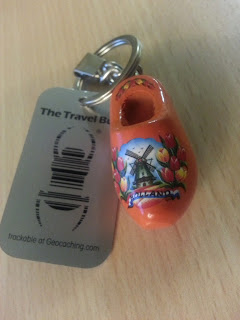So we started off our last day in The Netherlands with a bright, blue sunny sky, and <Spoiler Alert>, there was no rain for the first day of our trip.
Not to say that there isn't what we would consider typical graffiti around the city, we particularly loved these few that Anne pointed out to us. Her flat backs onto the back of Amsterdam University, and one year, when they were re-painting the outside of the building, one of her friends sneaked up the scaffolding one night as they were finishing, and added a little something to the wall.
He painted on a girl, holding a bouquet of balloons between the second story windows.
Whether at the same time, or another, he then added a few other characters around the courtyard, I think as friends to the wayward girl.
It was just a lovely day all around today, sun, not too hot, not too cold. Lovely day for exploring.
So a little bit on the symbols of Amsterdam. Throughout the week we kept seeing this in shops, on buildings, even stamped into manholes.
On the university gate
Above the university commons
As the university flag (sorry we started our day at the university)
Even on the penis shaped bollards throughout the city.
I thought it referred to the legalized prostitution and was an unofficial symbol of the city. Kristin though it referred to the various drugs and alcohol that are often consumed during a trip here. It turns out that the three x's on the red/black flag are actually the official city flag for Amsterdam.
Legend has it that the three x's are St. Andrew's Crosses, meant to ward off fire, flood and plague (although Amsterdam has used the symbols since before the Black Death arrived in Europe). It could also be that they are a nod to the original families that owned estates and land surrounding Amsterdam. The black stripe in the middle of the flag is used in several Dutch cities to symbolize the water that bisects the town, and is vitally important to the country. Kinda awesome how the city has chosen a flag that people are proud and happy to fly, whatever symbols they see it referring to.
At three different points on our trip, we came upon the Great Crested Grebes in the canals and waterways. As it's spring, these birds are starting to look for mates, they engage in a rather complicated and well choreographed dance to determine the suitability of their mate. We have captured a few of the pictures here, but there is a link that Kris found showing the procedure below. It involved lots of face each other, beaks almost touch, turn head left, look up, touch water on right, look back at each other, and on and on.
This is the last day of our trip here, we have to leave for the airport at 2:30, so we had intentionally left our day pretty open to 'mop up' on any activities we had missed so far. We opted to do a boat tour of the canals today. Give our feet a bit of a rest, and let someone else do the navigating. Having already seen the city on a bike, and enjoying the ease at which you can get around, the next best way to gain a different perspective on the city is from the water.







Housing is a big problem in Amsterdam. The city has very much outgrown its availability of real estate, so prices are skyrocketing, and a lot of people who have been able to afford it traditionally, are now finding themselves priced out of the city centre. Similar to Venice, the city is built on a marsh (essentially), so all the buildings are supported on wooden piles. It wasn't confirmed in the same way as in Venice, but I suspect the existing piles limit the height and size of any new buildings that were wanted to be built.
This is the smallest house in the Netherlands. It's 3 stories, and just over 6 feet wide. A husband and wife live there, complete with a dog! I'm just waiting to see this come to pass in Vancouver or Toronto.
Our captain pointed out to us that this is the largest parking lot in the world.... for bikes. As we've mentioned before, the Dutch are crazy about biking.
Even in high heels
But often this leads to other problems that many cities don't have to deal with. Including abandoned bikes, which can take up lots of otherwise available bike parking spaces. There is also the problem of bikes ending up in the various canals, either because they were stolen, and ditched there, or they were left along the canal on a bike rack for too long, and someone accidentally pitched them over the edge, like above.
But necessity is the mother of invention, so there are salvage barges like this one
Which trawl the canals, and remove all the various things that have accumulated on the bottom. We heard that up to 5000 bikes per year are pulled from the canal.
From the water, here is the Amsterdam Centraal Station. A perfect example of European efficiency!
This is the Nero, a marine museum, somewhat directed at children. It was built into the shape of a ship, and designed so that you can climb out onto the roof and look around.
This seems like a very permanent house boat. There are two different types of permits for houseboats in Amsterdam. The official permits allow for services including water, electricity and gas to be connected to the boat. Other unofficial ones, are left without all these services, and the residents are on their own to find services, or a way of living without.
Us enjoying the boat ride, and not having to walk / cycle around to see things.
Aaaaannnndddd profile pic!
I particularly loved this photo because the two bridges at 90° to each other have been constructed to look like they have been joined along the deck. So many bridges!
No modern city is complete without some odd pieces of architecture.
This is a miniture version of a famous floating restaurant in China. The Chinese original has capacity to seat 5000 diners. This one is only able to seat 700. In designing the building to as authentic specifications as possible, a slight miscalculation was used.... the weight of one diner was taken to be that of a chinese person, but the Dutch tend to be a little taller, and a little heavier than the average chinese person. Not a problem, there's always a safety factor. On the Gala opening night, the owner was so keen to impress, that he invited not 700, but 850 guests to the restaurant, and once all had arrived, it became obvious that the factor of safety had been exceeded, the resturant began to flood on the main floor, and the guests had to be evacuated! Oops!
This building used to be part of the fortifications of Amsterdam. It was added to over the centuries, but the original building (the lowest section) is from the 15 c. if I remember right.
So you may notice that the building here doesn't quite look right.... As mentioned, Amsterdam is built on a marshy area, so most of the buildings are supported on piles. Over the last several hundred years, many of the buildings have shifted and settled, and now have a noticeable lean to them. We guessed that all of the various leans and slants were due to this, but we were informed otherwise by our boat captain.

Since most buildings do not have a stairway inside the building that is wide enough to move furniture in and out, the majority are fitted with a hook in the top of the house, on which a pulley can be attached and all your belongings hauled in and out of the upper floors of the house. While it may look like the building above is falling forward as it settles, this was (apparently) intentional, and serves two purposes. The first is it makes it easier to move furniture in and out, without breaking windows or damaging your furniture. The second is that it reduces the amount of water hitting the windows, and the need to clean the windows (or in older days, the amount of water that would run into the house). That's the front to back lean that you see.
The side to side lean however, just means you have a sinking house.
A perfect last day in Amsterdam!
So Anne owns a juggling / magic / busker supply store near Amsterdam University. It was an awfully convenient meeting place for us. As we were heading out of town, Whitney wanted to show Anne what she had learned using the professional juggling balls that Dad bought many years ago.
They tried to coordinate a two person juggle. It isn't ready for the big stage yet, but they managed well for a first try.
And with that, we headed back to the train station.
Just a couple of quick stops along the way.
We didn't wander in, and I swear we held our breath as we passed, but this is one of the famous Amsterdam Coffee Shops.
We also found the oldest gay bar in Amsterdam, Cafe t'Mandje as we meandered back. This bar dates back to 1927. During the Nazi occupation, the bar owner housed jewish people in the attic, weapons in the basement and German schnapps behind the bar.
And what could possibly make for a better last experience in The Netherlands than a raw herring from a street meat trailer. I wouldn't say it was good, but with some pickles and onions, it was bearable. I can't help but think we earned our honourary Dutch credentials on this trip.
We also found, and started off a new Geocaching Travelbug. Started in Amsterdam, checked into England, and sent back to Canada with Whitney, we'll see how many times this little traveller can criss-cross the pond between Canada and the Netherlands.
Kristin loved this one. Every time we arrive at an airport, we have to find a place to dump out our water bottle before going through security, only to search for a place to fill it up again. This usually means using a garbage bin. In the train station area, they have provided plants for you to pour out your water! What a brilliant idea!
And now our last flight on this trip. Whitney still had 2 more to go before she made it home, but after a frenzied fortnight, I think we were all pleased with how the trip turned out.
All for now.
I started this post before we went to Malta, I'm finishing it now after we've returned, so there are 7 days of SCUBA diving still to come.



































































































